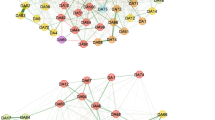Abstract
To determine whether Beck Depression Inventory (BDI) responses could be influenced by an instructional set or by changing the item order, 198 college students were randomly assigned to one of four conditions: instructions designed to facilitate or inhibit responding, along with standard vs. reordered symptom questions. A 2×2 ANCOVA found a main effect only for the inhibitory message. The suppression of scores by the inhibitor instructional set suggests caution regarding possible demand characteristics when using the BDI with this population and should be further studied with clinically symptomatic samples.
Similar content being viewed by others
References
Barker, L. L., & Jessup, B. A. (1980). The psychophysiology of affective verbal and visual information processing in dysphoria.Cognitive Therapy and Research, 4 135–148.
Bech, P., Gram, L. F., Dein, E., Jacobsen, O., Vitger, J., & Bolwig, T. G. (1975). Quantitative rating of depressive states: Correlations between clinical assessment, Beck's Self Rating Scale and Hamilton's Objective Rating Scale.Acta Psychiatrica Scandinavia, 51 161–170.
Beck, A. T., Ward, C. H., Mendelsohn, M., Mock, J., & Erbaugh, J. (1961). An inventory for measuring depression.Archives of General Psychiatry, 4 561–571.
Bosse, J. J., Croghan, L. M., Greenstein, M. B., Katz, N. W., Oliver, J. M., Powell, D. A., & Smith, W. R. (1975). Frequency of depression in the freshman year as measured in a random sample by a retrospective version of the Beck Depression Inventory.Journal of Consulting and Clinical Psychology, 43 747–756.
Bumberry, W., Oliver, J. M., & McClure, J. N. (1978). Validating the Beck Depression Inventory in a university population using psychiatric estimate as the criterion.Journal of Consulting and Clinical Psychology, 46 150–155.
Fiske, D. W., & Bourne, E. J. (1977). Thresholds for attributing can affect factorial structure.Educational and Psychological Measurement, 37 713–723.
Golin, S., & Hartz, M. A. (1979). A factor analysis of the Beck Depression Inventory in a mildly depressed population.Journal of Clinical Psychology, 35 324–325.
Golin, S., Jarrett, S., Stewart, M., Drayton, W. (1980). Cognitive theory and the generality of pessimism among depressed persons.Journal of Abnormal Psychology, 89 101–104.
Hammen, C. G. (1980). Depression in college students: Beyond the BDI.Journal of Consulting and Clinical Psychology, 48 126–128.
Hammen, C. G., & Padesky, C. A. (1977). Sex differences in the expression of depressive responses on the Beck Depression Inventory.Journal of Abnormal Psychology, 86 609–614.
LaPointe, K. A., & Crandell, C. J. (1980). Relationship of irrational belief to self reported depression.Cognitive Therapy & Research, 4 247–250.
Miller, W. R., & Seligman, M. E. P. (1975). Depression and learned helplessness in man.Journal of Abnormal Psychology, 84 228–238.
Oliver, J. M., & Burkham, R. (1979). Depression in university students as measured in random samples.Journal of Abnormal Psychology, 88 667–670.
Oliver, J. M., & McGee, J. (1982). Cognitions as a function of depression in a student population: Content & complexity of cognition.Cognitive Therapy & Research, 61 275–286.
Propst, L. R. (1980). The comparative efficacy of religious and non-religious imagery for the treatment of mild depression in religious individuals.Cognitive Therapy & Research, 4 167–178.
Rehm, L. P., Fuchs, C. Z., Roth, D. M., Kornblith, S. J., Romano, J. (1979). A comparison of self control and assertion skills treatments of depression.Behavior Therapy, 10 429–442.
Rosenbaum, M. (1984). A schedule for assessing self control behaviors: Preliminary findings.Behavior Therapy (in press).
Seligman, M. E. P. (1974). Depression and learned helplessness. In R. J. Friedman & M. M. Katz (Eds.),The psychology of depression: Contemporary theory and research. New York: Winston-Wiley.
Seligman, M. E. P. (1975).Helplessness: On depression, development and death. San Francisco: W. C. Freeman.
Velton, E. (1968). A laboratory task for the induction of mood states.Behavior Research and Therapy, 6 473–482.
Watson, D., & Friend, R. (1969). Measurement of social evaluation anxiety.Journal of Consulting and Clinical Psychology, 33 448–457.
Weckowicz, T. E., Muir, W., & Cropley, A. J. (1967). A factor analysis of the Beck Inventory of Depression.Journal of Consulting Psychology, 31 23–28.
Woods, D. J., & Beecher, G. P. (1979). Distinction within the concept of the inherently helpful person.Journal of Clinical Psychology, 35 108–109.
Author information
Authors and Affiliations
Rights and permissions
About this article
Cite this article
Kornblith, S.J., Greenwald, D.P., Michelson, L. et al. Measuring the effects of demand characteristics on the Beck Depression Inventory responses of college students. Journal of Behavioral Assessment 6, 45–49 (1984). https://doi.org/10.1007/BF01321460
Accepted:
Issue Date:
DOI: https://doi.org/10.1007/BF01321460




